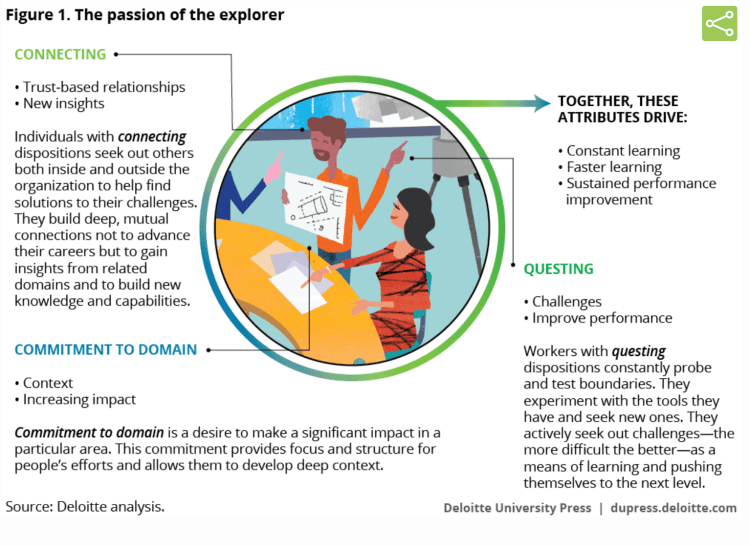AMERICAN companies will spend over $1 billion on employee engagement in 2017 and over $100 billion on training and development activities. Yet despite this investment, employee engagement remains low, at 34 percent. Perhaps more troubling: In an increasingly unpredictable business environment, most US workers, even those who are engaged, lack the disposition to embrace unexpected challenges and opportunities.
In fact, in a recent survey of US workers, only 35 percent had the disposition to seek out challenges; even among engaged employees, only 38 percent reported seeking challenges.
An even smaller number, 13 percent, have what we call “the passion of the explorer,” meaning not only do they seek out difficult challenges—they are committed to making a significant impact and regularly connect with others to gain the skills and insights to do so. The lack of passion for taking on challenging problems exists at all levels and job types, with 64 percent of all surveyed workers, including half of executives and senior management, being neither passionate nor engaged.
Does it matter? We believe it does. In the face of rapid technological change and global competition for talent, capital, and customers, we’re focused on the wrong thing, or at least too narrowly, if the intense investment in employee engagement has not produced employees willing and able to take on challenging issues and pursue new opportunities.
In this environment, the answer to improving performance is not to squeeze harder. At best, that’s a short-term answer—the gains will likely be competed away. A more sustainable advantage will likely come not from squeezing harder but from learning faster: learning what customers need and want, learning how to create more value for the customer, learning how to better and more profitably deliver and capture value. This isn’t “learning” in the classic training-program, knowledge-management sense of the word: The learning that matters, that can create real value in this environment, is about creating new knowledge. The scary thing about this type of learning is that it is inherently high-risk—it requires the willingness to fail as one seeks out new approaches that work.
The three attributes of worker passion—the tendency to seek out difficult challenges, the tendency to connect with others to find better solutions, and the desire to make a significant impact—drive the risk-taking that is necessary for this type of learning. They are crucial for a workforce that can think flexibly, learn quickly, and create new tools and approaches for new contexts. And we believe that without that passion, companies won’t find sustained performance improvement.
The next question is why workers lack this passion for taking on challenges. Broadly, three factors contribute to this gap. First, the same technological trends and sense of instability putting pressure on firms are also increasing the pressure felt by individual workers. For many, this leads to defensive, risk-minimizing behaviors oriented toward the short term.
Second, many American employees are still in work environments that do not encourage—and in some cases actively discourage—people from experimenting and feeling invested in exploring a range of alternatives for solving difficult challenges. Despite layers of new technology and fresh paint, many work environments have not meaningfully departed from the command-and-control structure of the last century. Too many managers still expect workers to perform the rigidly specified and highly standardized tasks laid out in process manuals.
Third, as companies and other organizations come under pressure, they, too, are reacting with short-term, risk-averse behavior, demanding that employees deliver results quickly—“and don’t mess it up.” Failure is unacceptable. Employees acting out of fear don’t take risks or seek challenges.
In this report, drawing on the findings from a survey of 3,059 US workers, we explore why employees may be unwilling or unable to take on problems and pursue new opportunities that might improve performance. We will show data that suggests a need both for greater latitude and flexibility and for the scaffolding and tools to use that license effectively. Further, we propose actionable ways that leaders can begin to cultivate a workforce that is ready, and enthusiastic, to step up to tomorrow’s challenges:
Lead by example. With the majority of surveyed executives and management neither engaged nor passionate, the first step is to commit to making a personal change, not just an organizational one. Ask yourself: What is keeping me from stepping up with enthusiasm for the challenge rather than fear of failure? Find the passionate people in the organization, and shine a light on their efforts—and your own—to build acceptance for risk-taking and experimentation.
Provide focus. Understanding what matters and where to direct our efforts is a prerequisite to making effective use of autonomy. Workers often lack visibility into the impact of their efforts. Specialization and silos further prevent employees from gaining the perspective needed to address, or even be aware of, challenges. Help employees frame powerful questions and recognize what’s interesting or important about new challenges.
Create the environment. If organizations are what they measure, they are also what they celebrate. Providing space and sufficient latitude to encourage and develop self-direction and challenge-seeking at different levels of the organization cannot be accomplished without also rethinking the way a group or unit is measured. Encourage employees to work with others with whom they can learn and let these workgroups begin to take on more responsibility and autonomy in doing the work of the organization. Celebrate efforts that create knowledge that might lead to higher performance, and eliminate the real disincentives that prevent all but the bravest from taking risks.
Chosen excerpts by Job Market Monitor. Read the whole story at Building a more passionate future workforce | Deloitte University Press




Discussion
No comments yet.